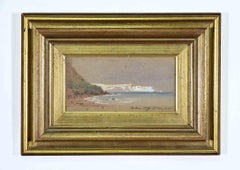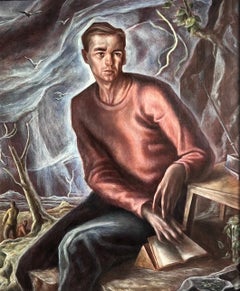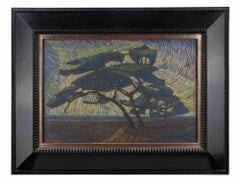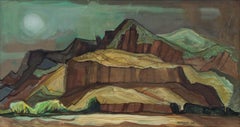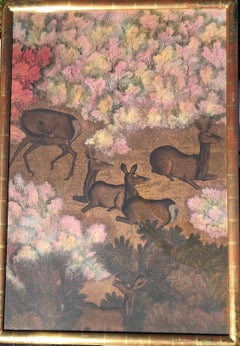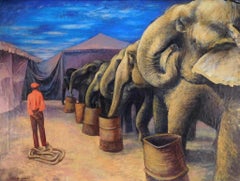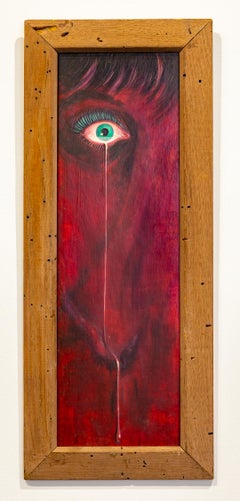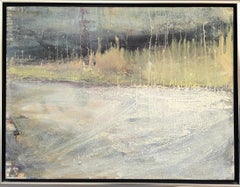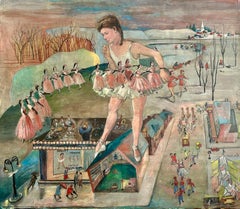Tempera Landscape Paintings
to
4
8
5
3
4
1
Overall Width
to
Overall Height
to
2
19
1
1
4
1
2
2
2
23
21
20
11
8
4
3
1
1
1
14
7
12
5
4
3
3
3
2
2
2
2
2
1
1
1
1
1
1
1
1
1
1,373
2,536
1,934
951
919
2
1
1
1
1
13
4
13
7
Style: Modern
Medium: Tempera
View of Culver Cliff, Isle of Wright - Oil paint attr. William Dyce - 1873
Located in Roma, IT
Oil and tempera on cardboard attributed to William Dyce and realized in 1873.
Hand titled and dated lower right.
Includes a modern gilded wooden frame, cm. 23.5x32.5.
Category
1870s Modern Tempera Landscape Paintings
Materials
Oil, Tempera
$570 Sale Price
20% Off
Self Portrait
Located in Los Angeles, CA
Self-Portrait, c. 1940, oil and tempera on Masonite, artist’s name inscribed verso, 30 x 25 inches
William Ashby McCloy was an American artist, educator, and clinical psychologist. ...
Category
1940s American Modern Tempera Landscape Paintings
Materials
Masonite, Oil, Tempera
Landscape - Painting by Nicolas Alexandrovitch Tarkhoff - Early 20th Century
Located in Roma, IT
Outstanding tempera on paper realized by Nicolas Alexandrovitch Tarkhoff (1871-1930) in the early 20th Century.
Hand signed lower left.
Includes a beautiful coeval wooden frame.
P...
Category
Early 20th Century Modern Tempera Landscape Paintings
Materials
Tempera
Rabbit Hunters
By Roger Medearis
Located in Los Angeles, CA
Rabbit Hunters, egg tempera on Masonite, 12 x 9 inches, 1947, signed and dated lower left, signed, titled and dated verso “Rabbit Hunters Egg Tempera Roger Medearis 1947,” exhibited at Medearis' solo show at Kende Galleries, New York, in 1949 (Medearis’ record book, a copy of which is held by Vose Galleries in Boston, MA, indicates this is painting “No. 23” and that is was completed in 1947 and sold via Kende Galleries (at Gimbel Brothers...
Category
1940s American Modern Tempera Landscape Paintings
Materials
Tempera, Board
Spring Storm by Doel Reed, 1980 Southwestern Modernist Landscape Painting
By Doel Reed
Located in Denver, CO
"Spring Storm" is a powerful original painting by acclaimed American modernist Doel Reed (1894–1985), celebrated for his dramatic Southwestern landscapes and mastery of tone and text...
Category
1980s American Modern Tempera Landscape Paintings
Materials
Casein
$9,200 Sale Price
36% Off
Reindeer In The Forest Chinese
Located in Lake Worth Beach, FL
Reindeer In Forest
Tempera on silk, gold leaf frame under glass, by Chinese artist Ma Hai Feng born 1958.
Category
1980s Modern Tempera Landscape Paintings
Materials
Silk, Egg Tempera
The Lonely Road by William Charles Palmer
Located in Hudson, NY
The Lonely Road (1940)
Tempera on panel
12" x 16"
19 1/2" x 23 1/2" x 1 1/2" framed
Hand-signed "Palmer '40" lower center.
Provenance: Midtown Galleries, New York, NY (labels verso...
Category
Mid-20th Century American Modern Tempera Landscape Paintings
Materials
Tempera, Panel
Manayunk Schuylkill River Factory City Scene Philadelphia GIOVANNI MARTINO 1970
Located in Rancho Santa Fe, CA
Provenance: Private Collection, San Diego, CA.
Framed
Giovanni Martino, National Academy of Design* member, was born on May 1, 1908 in Philadelphia PA where all seven brothers and one sister, Filomina, Frank, Antonio, Albert, Ernest, Giovanni, Edmond, and William became painters. They were under the tutelage of their eldest brother, Frank, who in the late 1920s, founded the first commercial art* studio, Martino Studios, at 27 South 18th Street.
Besides studying with his two eldest brothers, Giovanni also studied with Albert Jean Adolph at La France Institute, The Pennsylvania Academy of the Fine Arts*, The Graphic Sketch Club, and Spring Garden Institute in Philadelphia. In his mid teens he accompanied his two eldest brothers to New Hope searching for subjects to paint. In the 1930s, he also started to paint in Manayunk, a hilly mill town along the Schuylkill River. At this time he signed his paintings M. Giovanni.
These colorful impressionistic* works proceeded more thinly painted dramatically poetic street scenes of the mill town. These images developed into impasto* laden oils in the 1960's with some of the paintings worked with a palette knife*.
In Manayunk, he was a common sight on the streets and sidewalks, painting on-the-spot with his wife, Eva Marinelli and his two daughters, Nina & Babette. In the 1980's and 90's he also painted in Conshohocken and Norristown with his youngest daughter, Babette. His paintings became more sharply executed like his earlier work but were more colorful. In the late '90's he worked in his studio to enlarge paintings.
He is the recipient of over 100 awards and honors. He received the Benjamin Altman Prize in Landscape Painting in 1975 at the National Academy of Design, NYC where he was elected an Academician (NA) in 1944. He mentored not only his wife and two daughters but also taught at Lehigh University and the Graphic Sketch Club, Philadelphia.
He died at his home in Blue Bell on February 1, 1997. (Babette Martino...
Category
1970s American Modern Tempera Landscape Paintings
Materials
Paper, Mixed Media, Oil, Tempera
Bird in Cage
Located in New York, NY
Gouache on board, 20 x 24 in.
Signed (at lower right): Atherton
Painted about 1940
RECORDED: Art News (May 11, 1940), illus. [clipping citation]
EXHIBITED: The Art Institute of Chicago, 1940, The International Watercolor Exhibition, no. 156, illus. on cover as Bird in Cage...
Category
Mid-20th Century American Modern Tempera Landscape Paintings
Materials
Tempera, Wood Panel
Suburbs - Painting by Renzo Vespignani - 1970s
Located in Roma, IT
Suburbs is an original modern artwork realized by Renso Vespignani in 1970s.
Mixed colored tempera on canvas.
Stamp behind the artwork.
Provenance: Vivaldi Collection.
Category
1970s Modern Tempera Landscape Paintings
Materials
Tempera
“Central Park in Winter, 1949” Manhattan New York City Snow Day Sleds Children
Located in Yardley, PA
With a studied hand, Sloan captures the human theater of a snow-covered Central Park filled with bundled-up New Yorkers, sledding, walking, chatting, and caring for children. The exp...
Category
1940s American Modern Tempera Landscape Paintings
Materials
Tempera, Oil, Masonite
Venetian Canal, Early 20th Century Landscape Scene, Cleveland School Artist
By Frank Wilcox
Located in Beachwood, OH
Venetian Canal, c. 1910-11
Tempera on board
Signed lower right
24 x 30 inches
30 x 36 inches, framed
Frank Nelson Wilcox (October 3, 1887 – April 17, ...
Category
1910s American Modern Tempera Landscape Paintings
Materials
Tempera
'Architectural', Exhibited: Buffalo Fine Arts Academy, Albright Art Gallery
Located in Santa Cruz, CA
Modernist Apartment Building by J. Katulski (American, 20th century), painted circa 1950 and titled, verso, 'Individuals'.
Exhibited circa 1950: Buffalo Fine Arts Academy, Albright A...
Category
Mid-20th Century American Modern Tempera Landscape Paintings
Materials
Tempera, Casein, Board
Mosque in Constantinople - Drawing - Mid-20th Century
Located in Roma, IT
Mosque in Constantinople is an original artwork realized in the mid-20th century, and attributed to Gustavo Francalancia.
Original mixed colored tempera and watercolor on plywood.
...
Category
Mid-20th Century Modern Tempera Landscape Paintings
Materials
Tempera, Watercolor
TheLake - Tempera on Cardboard by Marius Carion - 1940s
Located in Roma, IT
The Lake is an artwork realized in the 1940s by Marius Carion (Belgian, 1898 - 1949).
Original tempera painting on cardboard.
The artwork has the name of the author hand-written in...
Category
1940s Modern Tempera Landscape Paintings
Materials
Tempera
Untitled Acrylic Architectural Landscape Painting
Located in Houston, TX
Architectural landscape painting by Anthony V. Martin of a white house with a lovely green velvet mat and a gold frame.
Artist Biography: Anthony V. Martin grew up in east Texas. H...
Category
1960s Modern Tempera Landscape Paintings
Materials
Egg Tempera
The Valley of the Temples - Mixed Colored Tempera on Paper - Mid-19th Century
Located in Roma, IT
The Valley of the Temples is an original modern artwork realized in 19th century.
Mixed colored tempera on paper.
Includes frame.
Titled on the lower margin: Veduta del tempio esa...
Category
Mid-19th Century Modern Tempera Landscape Paintings
Materials
Tempera, Paper
Roman Countryside - Mixed Media by E. Gioja - 1908
By Edoardo Gioja
Located in Roma, IT
Roman Countryside is a modern artwork realized in 1908 by Edoardo Gioja.
Mixed media on wood panel. Hand signed and dated on the lower right margin.
Includes frame.
Edoardo Gioja (Rome, 1862 - Rome, 1937), an Italian painter and artist. He treated the decoration and portrait with Pre-Raphaelite taste. Influenced by Nino Costa, he repudiated genre painting by reproducing marines, countries, plants, animals and painted and drew with simplicity and with very effective results. He decorated several rooms in London and prepared cartoons for stained glass...
Category
Early 1900s Modern Tempera Landscape Paintings
Materials
Tempera, Wood Panel
Night Fantasy - Original Tempera by Jean Raymond Delpech - 1960s
By Jean Delpech
Located in Roma, IT
Night Fantasy is an original tempera painting on cardboard, realized around 1960's by the French artist, Jean Raymond Delpech (1988-1916).
This...
Category
1960s Modern Tempera Landscape Paintings
Materials
Tempera
The Cavern 1950 painting by John Atherton
Located in Hudson, NY
Signed lower right: "Atherton", inscribed "John Atherton Original Tempera 7/28/50" on verso.
Artwork measures 16" x 20" and framed 20" x 24" x 2 ½"
About this artists: John Atherton (1900-1952) did not show an early aptitude for art; rather, his first love was nature and the activities he relished there, mainly fishing and hunting. Born in Brainerd, Minnesota in 1900, he learned to fish with his father from the age of four. Later the family moved to Spokane, Washington, and when he was old enough, Atherton worked at a variety of jobs to help support his family. One such job, in the sorting plant of a lead and silver mine, paid $4.25 a day—a good wage, though he never had time to spend his money, since he worked seven days a week.
After serving in the Navy for a year during World War I, Atherton was determined to get an education. He worked as a sign painter and played the banjo in a dance band, finally accumulating enough money to enroll in the California School of Fine Arts in San Francisco. Once there, he worked like a fiend, attending classes both during the day and at night, getting the best training available.
Though he had always intended to be a fine artist, Atherton’s first jobs were for commercial art firms. In 1929, using the prize money won for a painting he entered in an art competition, Atherton and his wife moved to New York City. Though the economic situation was difficult in those years, he managed to keep going by taking commissions for magazine illustrations, and over the years he would paint more than forty covers for The Saturday Evening Post.
In 1938, an artist friend suggested that he use the same flat, decorative style as his commercial work for his gallery paintings. This was a breakthrough for Atherton; soon afterwards he held a one-man show at the Julien Levy Gallery in New York, and his paintings began to be collected by museums including the Museum of Modern Art in New York and the Metropolitan Museum of Art.
Atherton’s reputation increased to a national scale when he designed the art deco stone lithograph poster for the 1939 World’s Fair that strikingly depicted Earth and its atmospheric layers in the lap of Liberty.
Atherton was highly influenced by the magic realist...
Category
1950s Modern Tempera Landscape Paintings
Materials
Masonite, Tempera
Tending the Garden
Located in Missouri, MO
Robert Elton Tindall (1913-1983)
"Tending the Garden" (Girl with a Hoe) c. 1940
Egg Tempera with Resin Oil Glazes on Panel
Signed Lower Left
Site: 10 x 9 inches
Framed: 15 x 14 inch...
Category
Mid-20th Century American Modern Tempera Landscape Paintings
Materials
Egg Tempera, Wood Panel
Price Upon Request
Related Items
Circus Elephants American Modernism WPA Regionalism Mid-Century Modern Oil
Located in New York, NY
Circus Elephants American Modernism WPA Regionalism Mid-Century Modern Oil. Signed lower left.
Not much is known about Marco de Marco, but just look at...
Category
1930s American Modern Tempera Landscape Paintings
Materials
Canvas, Oil
$6,900
H 32 in W 40 in D 3 in
"Don't Cry Long" Abstracted and Distorted Self-Portrait, One Crying Eye
Located in Detroit, MI
"Don't Cry Long" is a self-portrait of the artist and an unusual one at that in which the artist portrays herself shedding tears. Perhaps it is an expression of some grief experienced by Ms. Woodlock, but it also admonishes her to not "Cry Long" while at the same time poking fun because of her elongated face and the one lone "long" tear tracing a pattern down her face. In addition to self-portraits, Ethelyn painted commissioned portraits. In this painting her head is cocked and her famous bangs hang down her forehead. Compare two self-portraits, “Up From Under”, and “M’Eyes" to "Don't Cry Long." The major differences are the close facial view and the brilliant blood red paint that fills the entire canvas.
This painting is included in the book, "Dreams Have Wings: An Artist's Journey into Magic and Mystery" printed in the United States, 1985. She describes "Don't Cry Long" as showing how funny looking we are, if we cry too long.
Ethelyn Woodlock...
Category
Mid-20th Century American Modern Tempera Landscape Paintings
Materials
Oil, Masonite
Large Antique American Bahamian Young Woman Portrait Signed Rare Oil Painting
Located in Buffalo, NY
Really rare and well painted portrait by Christine Walters Martin (1895-1982). Oil on canvas. Framed in a nice modernist molding. Signed.
Artist Bio:
Christine Walters Martin (1895-1982)
Born and raised in Brooklyn, Christine Martin majored in art at Columbia University/Teachers College. She spent summers painting at the Woodstock Art Colony under the tutelage of artists there and continued her art studies at the Art Student's League in New York City. Over the years, her teachers included John Sloan, Yasuo Kuniyoshi, Alexander Brook and John McFee. She also studied with Eugene Speicher, who recommended her for Portraits Inc, through which some of his own commissions came. Much later in life, in her 80s, Christine studied watercolor with Zoltan Szabo.
Before marrying attorney George Martin in 1923, she taught art in the New York public schools for several years. During summers in the late 1920s, after having two daughters (Cynthia, 1924-2008, and Joan, 1927-2000), she went to Woodstock with her girls in tow, staying at the Hasbrook farm. In 1930, she and her husband purchased a stone house on Ohayo Mountain Road and lived there seasonally for 25 years. Among her closest artist friends in Woodstock were Emil Ganso, Florence Hardiman, Albert Heckman, Peggy Dodds, Joe Rollo, Henry Mattson, Mary Ellen Early, and Maud and Miska Petersham, along with Juliana Force (Whitney Museum). During many summers in Woodstock, Christine's daughters Cynthia and Joan kept up their serious piano studies under the tutelage of Vladimir Padwa and Inez Carroll.
Known for portraits and landscapes, she was a member of the National Association of Women Artists and the National Arts Club, Gramercy Park, NY. Her work showed at the National Arts Club, Weyhe and Preston Galleries and the National Academy of Design in New York; the Pennsylvania Academy in Philadelphia; the Woodstock Art Association and Rudolf Galleries in Woodstock, Vermont's Dawson Grist Mill Gallery, and South Hampton College, among others. Her portraits, landscapes and still lives hang in hundreds of homes around the world.
Information provided by Bunny McBride...
Category
1920s Modern Tempera Landscape Paintings
Materials
Canvas, Oil
$2,495 Sale Price
48% Off
H 45 in W 35 in D 3 in
Maine Morning
Located in Wilton Manors, FL
Beautiful winter landscape by American artist, J. Philip Richards (1906-1991). Maine Morning, 1974. Casein on paper, 16 x 26 inches; 26 x 36 inches framed. Signed lower right. Signed, titled and dated on verso. Excellent condition.
Glass has been removed and will need to be replaced.
Born in Moosic, PA, and graduated from the College of Fine Arts of Syracuse University in New York, J Philip Richards worked and studied with such artists of international reputation as William Von Schlagell, James Fitzgerald, David Porter, and John Taylor.He was professor emeritus of Fine Arts at Wilkes College in Wilkes-Barre, PA. Member of the American Watercolor Society, NYC, NY; York Artists Association, York, ME; Ogunquit Art Association, Ogunquit, ME; Wyoming Valley Art League, Wilkes-Barre, PA; National Society of Casein Painters, NYC, NY; Director Ancestor's Art Workshops, Searsport, ME; Gallery Director, "Gallery 164," Kennebunk, ME; Professional Artists League of America, NYC, NY; Art Guild of Kennebunks, Kennebunk, ME; Maine Artists...
Category
1970s Impressionist Tempera Landscape Paintings
Materials
Casein
Frederick Shane “Twilight of History” 1947 Surrealist Oil Painting, Signed
Located in Denver, CO
"Twilight of History" is a powerful and evocative original oil painting on board by renowned American artist Frederick Shane (1906–1992), created in 1947. This deeply symbolic work e...
Category
1940s American Modern Tempera Landscape Paintings
Materials
Oil, Board
$3,750
H 24.5 in W 28.5 in D 2.75 in
Antique American Expressionist Signed Original Sunset Horse Landscape Painting
Located in Buffalo, NY
Vintage modernist expressionist sunset oil painting. Oil on canvas. Image size, 27.5L x 20H. Signed.
Category
1960s Modern Tempera Landscape Paintings
Materials
Canvas, Oil
$636 Sale Price
20% Off
H 20 in W 27.5 in D 2 in
"Woodstock Landscape" Albert Heckman, American Modernist, Atmospheric Valley
Located in New York, NY
Albert Heckman
Woodstock Landscape
Oil on board
10 x 8 inches
Albert Heckman was born in Meadville, Western Pennsylvania, 1893. He went to New York City to try his hand at the art ...
Category
1940s American Modern Tempera Landscape Paintings
Materials
Oil, Board
Cityscape Mid-20th Century Modern Social Realism American Scene Regionalism WPA
Located in New York, NY
Cityscape Mid-20th Century Modern Social Realism American Scene Regionalism WPA
Samuel Thal (1903 to 1964)
"Cityscene"
12 x 16 inches
Oil on board, c. 1940s
Signed verso
Framed: 19...
Category
1940s American Modern Tempera Landscape Paintings
Materials
Oil, Board
Lucky For You, Original painting, portrait, Landscape, Horses
Located in Deddington, GB
Lucky for you is an ode to the one you love and the want to be with them again. Norfolk, England in Autumn.
ADDITIONAL INFORMATION:
Acrylic paint, Canvas, Charcoal on Canvas
100 H x...
Category
2010s Modern Tempera Landscape Paintings
Materials
Canvas, Acrylic
$2,856
H 39.38 in W 39.38 in D 1.58 in
Downtown New York
Located in Los Angeles, CA
Downtown New York, c. 1930s, oil on canvas, signed lower right, 10 x 12 inches; label verso reads: "Harry Dix / Title Downtown New York / Medium Oil"
Harry Dix was a 20th-century p...
Category
1930s American Modern Tempera Landscape Paintings
Materials
Canvas, Oil
Antique American School WPA Modernist Black Figure Ashcan Dock View Oil Painting
Located in Buffalo, NY
Oil on canvas. Framed. Signed.
Category
1920s Modern Tempera Landscape Paintings
Materials
Canvas, Oil
$780 Sale Price
20% Off
H 36 in W 27 in D 2 in
"Georgia Moonshiner, c. 1935" by Athos Menaboni (1895-1990) American WPA Era Oil
Located in Yardley, PA
A fantastic WPA-era painting of a Georgia moonshiner by famed Italian-American artist Athos Menaboni (1895-1990).
This work depicts an older man sporting a brown hat, brown jacket, ...
Category
1930s American Modern Tempera Landscape Paintings
Materials
Masonite, Oil
$3,950
H 20 in W 18 in D 2 in
Previously Available Items
Vintage Mid-Century Modern Abstract Landscape Framed Tempera Painting - Rainfall
Located in Bristol, GB
RAINFALL
Size: 47.5 x 61.5 cm (including frame)
Tempera on Canvas
A mid-century abstract landscape that evokes a melancholic atmosphere, resembling a rainy day in nature, executed i...
Category
Mid-20th Century Modern Tempera Landscape Paintings
Materials
Canvas, Tempera
"A Dancer's Fantasy" WPA American Scene Mid 20th Century Social Realism Modern
Located in New York, NY
"A Dancer's Fantasy" WPA American Scene Mid 20th Century Social Realism Modern
Agnes Mills (1915 – 2008)
A Dancer’s Fantasy
48 x 55 inches
Tempera on masonite
Signed “Aggie Mills’ lower right
BIO
Painter, printmaker, and sculptor Agnes Eunice Mills was born in New York City on April 2, 1915 to Herman and Celia Karlin. A prolific multi-disciplinary arts, she specialized in dance subjects and imagery pertaining to the arts. She worked in the Long Island/New York City area for most of her career, eventually moving to Florida.
Mills was a graduate of Pratt Institute and Cooper Union Art School, and was associated with the Bauhaus, Social Realist, and Abstract movements. She worked for the WPA early in her career, becoming the youngest instructor in the Federal Arts Project along with fellow artist Ruth Gikow. She studied under Alexander Calder, Louise Nevelson, David Siqueiros, Hans Hoffman, Stanley William Hayter at Atelier 17 in New York, Krishna Reddy, and many other leading printmakers and painters of the time.
For 25 years she served as resident artist for the Alwin Nikolais Dance Company, and several other dance companies hired her to sketch their rehearsals. She was a member of the Artists Union and was Co-Chair for the committee for public use of art. She published the Index of American Design for the Library of Congress.
Solo Exhibitions:
Lincoln Center Art Gallery, New York City: Drawings & Prints on the Dance; City Center Gallery, NYC: Drawings & Prints on the Dance; Alfredo Valente Gallery, NYC: Sculpture, Drawings & Prints; Carus Gallery, NYC: Oils, Drawings & Prints; Harbor Gallery, Cold Spring Harbor, NY; Graphic Eye Co-op Gallery, Roslyn, NY; North Shore Community Arts Center, Great Neck, NY: Prints & Drawings on the Dance; Unitarian Society, Manhassett, NY: Sculpture, Drawings & Prints; North Truro Art...
Category
1930s American Modern Tempera Landscape Paintings
Materials
Masonite, Egg Tempera
The Carved Door – Semi-Abstract Tempera Landscape Painting with Flora & Fauna
By Archie Musick
Located in Denver, CO
"The Carved Door" is a captivating semi-abstract tempera painting by Colorado modernist Archie Musick (1902–1978). Signed by the artist in the lower right corner, this artwork beauti...
Category
Mid-20th Century American Modern Tempera Landscape Paintings
Materials
Tempera
H 22 in W 11 in D 0.75 in
The Courtyard, Greece. Mid Centruy Oil on Panel
Located in Cotignac, FR
Mid 20th Century oil on board view of a courtyard by Italian artist Paul Pennisi. Signed bottom left, presented in contemporary wood frame. There is also a Greek artists supplies label to the back of the panel which suggests the work was painted during his time in Greece.
Pennisi has manged to capture all the charm of an old manor house, with its decorative pediment, next to the other buildings in a courtyard. He has created a wonderful perspective with the range of buildings to the left which draw you in to the painting as if you are walking through and up to the steps and gate to the right. He has used an interesting colour palette to give all the vibrancy to the buildings yet the sky and right portion of the painting are almost as if a storm is approaching, a great contrast between light and shade. His technique means we can feel the age of the buildings and the texture of their facades, a very successful juxtaposition of roughness and smoothness to the paint surface.
Paul Pennisi was born in 1930 to an old Sicilian family, the Pennisi di Floristella, in Acireale.
He studied architecture at the University of Rome.
In 1964 he moved to Thessaloniki, Greece where he devoted himself exclusively to painting. There he studied the centuries old byzantine iconography techniques of the Mount Athos...
Category
Mid-20th Century Modern Tempera Landscape Paintings
Materials
Oil, Acrylic, Board, Casein
Americans Modernist Tempera Painting, Penguins in Snowy Landscape, Blue White
By Archie Musick
Located in Denver, CO
Original American Modernist tempera painting on masonite by Archie Musick (1902-1978). Signed by the artist in the lower right corner. Depicted is a landscape with penguins marching ...
Category
Mid-20th Century American Modern Tempera Landscape Paintings
Materials
Masonite, Tempera
H 10.5 in W 20.5 in D 0.75 in
"Untitled 2" Red, Blue, Pink, and Black Abstract Modernist Geometric Painting
By McKie Trotter
Located in Houston, TX
Red, blue, pink, and black abstract modernist painting by known Houston, TX artist McKie Trotter. This painting depicts various geometric rectangular shapes in red and pink against a black background.
Dimensions Without Frame: H 17 in. x W 24 in.
Artist Biography: McKie Trotter was born in 1918 in Manchester, Georgia. He pursued his growing interest in art, earning a Bachelor of Arts degree from the College of William and Mary in Williamsburg Virginia...
Category
1950s Modern Tempera Landscape Paintings
Materials
Masonite, Casein
H 19 in W 26 in D 0.88 in
End of the Meadow, 1970s Abstract Colorado Mountain Landscape Tempera Painting
Located in Denver, CO
End of the Meadow, original vintage 1970s painting by Colorado/Woodstock, NY woman artist, Ethel Magafan (1916-1993), semi Abstract Colorado Mountain Landscape, tempera on masonite in colors of yellow, gold, green, purple, blue, red and orange. Presented in a custom hardwood float frame, outer dimensions measure 30 x 41 ½ x 2 ¼ inches. Image size is 28 ¼ x 40 inches.
Painting is clean and in very good vintage condition - please contact us for a detailed condition report.
Provenance: Estate of Ethel Magafan
About the Artist:
The daughter of a Greek immigrant father and a Polish immigrant mother who met and married in Chicago, Ethel Magafan, her identical twin sister Jenne and their elder sister Sophie grew up in Colorado to which their father relocated the family in 1919. They initially lived in Colorado Springs where he worked as a waiter at the Antlers Hotel before moving to Denver in 1930 to be head waiter at the Albany Hotel. Two years later during the Great Depression Ethel and Jenne experienced at sixteen the tragic loss of their father who had encouraged their artistic aspirations
He was proud when Ethel, a student at Morey Junior High School, won top prizes in student poster contests sponsored by the Denver Chamber of Commerce and the Denver Post. At East High School in Denver she and Jenne contributed their art talents to the school's and by their senior year were co-art editors of the Angelus, the 1933 yearbook. At East they studied art with Helen Perry, herself a student of André Lhote in Paris and the Art Institute of Chicago. Her decision to abandon an arts career to teach high school students served as an important example to Ethel and Jenne, who early on had decided to become artists. In a city-wide Denver competition for high school art students Ethel won an eighteen-week art course in 1932-33 to study at the Kirkland School of Art which artist Vance Kirkland had recently established in the Mile High City.
Perry encouraged the Magafan twins' talent, exposing them to the work of Matisse, Picasso and Cézanne and introducing them to local artists and architects like Frank Mechau and Jacques Benedict whom she invited to speak in her high school art classes. She paid the modest tuition for Ethel and Jenne to study composition, color, mural designing and painting at Mechau's School of Art in downtown Denver in 1933-34. In the summer of 1934 and for a time in 1936 they apprenticed with him at his studio in Redstone, Colorado.
When they returned to Denver in 1934 with no family breadwinner to support them, their mother insisted that they have real jobs so they worked as fashion artists in a Denver department store. When Jenne won the Carter Memorial Art Scholarship ($90.00) two years later, she shared it with Ethel so that both of them could enroll in the Broadmoor Art Academy (now the Colorado Springs Fine Arts Center) where they studied with Mechau. When the scholarship money ran out after two months, he hired them as his assistants. Along with Edward (Eduardo) Chavez and Polly Duncan, they helped him with his federal government mural commissions. At the Fine Arts Center Ethel also studied with Boardman Robinson and Peppino Mangravite, who hired her and Jenne in 1939 to assist him in his New York studio with two murals commissioned for the post office in Atlantic City, New Jersey. Like their Denver high school art teacher, Robinson also stressed the need to draw from nature in order to "feel" the mountains, which later become the dominant subject matter of Ethel's mature work after World War II.
Mechau trained her and her sister in the complex process of mural painting while they studied at the Colorado Springs Fine Arts Center, teaching them the compositional techniques of the European Renaissance masters. This also involved library research for historical accuracy, small scale drawing, and the hand-making of paints and other supplies. Ethel recalled that their teacher "was a lovely man but he was a hard worker. He drove us. There was no fooling around."
Her apprenticeship with Mechau prepared her to win four national government competitions, beginning at age twenty-two, for large murals in U.S. post offices: Threshing - Auburn, Nebraska (1938), Cotton Pickers - Wynne, Arkansas (1940), Prairie Fire - Madill, Oklahoma (1940), and The Horse Corral - South Denver, Colorado (1942). In preparation for their commissions Ethel and her sister made trips around the country to pending mural locations, driving their beat-up station wagon, dressed in jeans and cowboy boots with art supplies and dogs in tow. She and Jenne combined their talents in the mural, Mountains in Snow, for the Department of Health and Human Services Building in Washington, DC (1942). A year later Ethel executed her own mural, Andrew Jackson at the Battle of New Orleans, January 8, 1814, for the Recorder of Deeds Building, also in Washington, DC. Her first mural commission, Indian Dance, done in 1937 under the Treasury Department Art Project for the Senate Chamber in the United States Capitol, has since disappeared.
Ethel and her sister lived and worked in Colorado Springs until 1941 when their residence became determined by the wartime military postings of Jenne's husband, Edward Chavez. They moved briefly to Los Angeles (1941-42) and then to Cheyenne, Wyoming, while he was stationed at Fort Warren, and then back to Los Angeles for two years in 1943. While in California, Ethel and Jenne executed a floral mural for the Sun Room of the Beverly Hills Hotel and also painted scenes of the ocean which they exhibited at the Raymond and Raymond Galleries in Beverly Hills. While in Los Angeles they met novelist Irving Stone, author of Lust for Life, who told them about Woodstock, as did artists Arnold Blanch and Doris Lee (both of whom previously taught at the Colorado Springs Fine Arts Center school. In summer of 1945 Ethel, her sister and brother-in-law drove their station wagon across the country to Woodstock which became their permanent home.
A year later Ethel married artist and musician, Bruce Currie, whom she met in Woodstock. In 1948 with the help of the GI Bill they purchased an old barn there that also housed their individual studios located at opposite ends of the house. The spatial arrangement mirrors the advice she gave her daughter, Jenne, also an artist: "Make sure you end up with a man who respects your work... The worst thing for an artist is to be in competition with her husband."
In 1951 Ethel won a Fulbright Scholarship to Greece where she and her husband spent 1951-52. In addition to extensively traveling, sketching and painting the local landscape, she reconnected with her late father's family in the area of Messinia on the Peloponnese peninsula in southern Greece. At the same time, her sister Jenne accompanied Chavez on his Fulbright Scholarship to Italy where they spent a productive year painting and visiting museums. Shortly after returning home, Jenne's career was cut tragically short when she died of a cerebral hemorrhage at age thirty-six. It deeply affected Ethel whose own work took on a somber quality for several years conveyed by a darkish palette, as seen in her tempera painting, Aftermath (circa 1952).
In the 1940s Ethel and her sister successfully made the important transition from government patronage to careers as independent artists. Ethel became distinguished for her modernist landscapes. Even though Ethel became a permanent Woodstock resident after World War II, from her childhood in Colorado she retained her love of the Rocky Mountains, her "earliest source of my lifelong passion for mountain landscape." She and her husband began returning to Colorado for annual summer camping trips on which they later were joined by their daughter, Jenne.
Ethel did many sketches and drawings of places she found which had special meaning for her. They enabled her to recall their vital qualities which she later painted in her Woodstock studio, conveying her feeling about places remembered. She also produced a number of watercolors and prints of the Colorado landscape that constituted a departure from the American Scene style of her earlier paintings. Her postwar creative output collectively belongs to the category of landscape abstractionists as described by author Sheldon Cheney, although to a greater or lesser degree her work references Colorado's mountainous terrain. She introduced a palette of stronger pastels in her paintings such as two temperas, Evening Mountains from the 1950s and Springtime in the Mountains from the early 1960s.
In 1968 she was elected an Academician by the National Academy of Design in New York. Two years later, based on results of her many summer trips to Colorado, the U.S. Department of the Interior invited her to make on-the-spot sketches of the western United States, helping to document the water resources development and conservation efforts by the Department of the Interior. Her sketches were exhibited at the National Gallery in Washington, DC, and then sent on a national tour by the Smithsonian Institution. Similarly, her previous work as a muralist earned her a final commission at age sixty-three for a 12 by 20 foot Civil War image, Grant in the Wilderness, installed in 1979 in the Chancellorsville Visitors Center at the Fredericksburg National Military Park in Virginia. In the 1970s, too, she taught as Artist-in-Residence at Syracuse University and at the University of Georgia in Athens. ©Stan Cuba for David Cook Galleries, LLC
Her many awards include, among others, the Stacey Scholarship (1947); Tiffany Fellowship (1949); Fulbright Grant (1951-52, in Greece with her husband); Tiffany Fellowship (1949); Benjamin Altman Landscape Prize, National Academy of Design (1955); Medal of Honor, Audubon, Artists (1962); Henry Ward Granger Fund Purchase Award, National Academy of Design (1964); Childe Hassam Fund Purchase Award, American Academy of Arts and Letters (1970); Silver Medal, Audubon Artists (1983); Champion International Corporation Award, Silvermine Guild, New Canaan, Connecticut (1984); John Taylor Award, Woodstock Artists Association, Woodstock, New York (1985); Harrison Cady...
Category
Mid-20th Century American Modern Tempera Landscape Paintings
Materials
Masonite, Tempera
H 30 in W 41.5 in D 2.25 in
Distant Country (Semi-Abstract Mountain Landscape: Purple, Gold, Green, Brown)
Located in Denver, CO
Distant Country, original vintage mid-century modern style painting by 20th century Colorado/Woodstock woman artist, Ethel Magafan (1916-1993) of an abstract Colorado mountain landscape in colors of blue, purple, brown, gold, green and ivory. Presented in a vintage frame, outer dimensions measure 22 ¾ x 25 x 1 ¾ inches. Image size 17 x 19 ½ inches.
The daughter of a Greek immigrant father and a Polish immigrant mother who met and married in Chicago, Ethel Magafan, her identical twin sister Jenne and their elder sister Sophie grew up in Colorado to which their father relocated the family in 1919. They initially lived in Colorado Springs where he worked as a waiter at the Antlers Hotel before moving to Denver in 1930 to be head waiter at the Albany Hotel. Two years later during the Great Depression Ethel and Jenne experienced at sixteen the tragic loss of their father who had encouraged their artistic aspirations
He was proud when Ethel, a student at Morey Junior High School, won top prizes in student poster contests sponsored by the Denver Chamber of Commerce and the Denver Post. At East High School in Denver she and Jenne contributed their art talents to the school's and by their senior year were co-art editors of the Angelus, the 1993 yearbook. At East they studied art with Helen Perry, herself a student of André Lhote in Paris and the Art Institute of Chicago. Her decision to abandon an arts career to teach high school students served as an important example to Ethel and Jenne, who early on had decided to become artists. In a city-wide Denver competition for high school art students Ethel won an eighteen-week art course in 1932-33 to study at the Kirkland School of Art which artist Vance Kirkland had recently established in the Mile High City.
Perry encouraged the Magafan twins' talent, exposing them to the work of Matisse, Picasso and Cézanne and introducing them to local artists and architects like Frank Mechau and Jacques Benedict whom she invited to speak in her high school art classes. She paid the modest tuition for Ethel and Jenne to study composition, color, mural designing and painting at Mechau's School of Art in downtown Denver in 1933-34. In the summer of 1934 and for a time in 1936 they apprenticed with him at his studio in Redstone, Colorado.
When they returned to Denver in 1934 with no family breadwinner to support them, their mother insisted that they have real jobs so they worked as fashion artists in a Denver department store. When Jenne won the Carter Memorial Art Scholarship ($90.00) two years later, she shared it with Ethel so that both of them could enroll in the Broadmoor Art Academy (now the Colorado Springs Fine Arts Center) where they studied with Mechau. When the scholarship money ran out after two months, he hired them as his assistants. Along with Edward (Eduardo) Chavez and Polly Duncan, they helped him with his federal government mural commissions. At the Fine Arts Center Ethel also studied with Boardman Robinson and Peppino Mangravite, who hired her and Jenne in 1939 to assist him in his New York studio with two murals commissioned for the post office in Atlantic City, New Jersey. Like their Denver high school art teacher, Robinson also stressed the need to draw from nature in order to "feel" the mountains, which later become the dominant subject matter of Ethel's mature work after World War II.
Mechau trained her and her sister in the complex process of mural painting while they studied at the Colorado Springs Fine Arts Center, teaching them the compositional techniques of the European Renaissance masters. This also involved library research for historical accuracy, small scale drawing, and the hand-making of paints and other supplies. Ethel recalled that their teacher "was a lovely man but he was a hard worker. He drove us. There was no fooling around."
Her apprenticeship with Mechau prepared her to win four national government competitions, beginning at age twenty-two, for large murals in U.S. post offices: Threshing - Auburn, Nebraska (1938), Cotton Pickers - Wynne, Arkansas (1940), Prairie Fire - Madill, Oklahoma (1940), and The Horse Corral - South Denver, Colorado (1942). In preparation for their commissions Ethel and her sister made trips around the country to pending mural locations, driving their beat-up station wagon, dressed in jeans and cowboy boots with art supplies and dogs in tow. She and Jenne combined their talents in the mural, Mountains in Snow, for the Department of Health and Human Services Building in Washington, DC (1942). A year later Ethel executed her own mural, Andrew Jackson at the Battle of New Orleans, January 8, 1814, for the Recorder of Deeds Building, also in Washington, DC. Her first mural commission, Indian Dance, done in 1937 under the Treasury Department Art Project for the Senate Chamber in the United States Capitol, has since disappeared.
Ethel and her sister lived and worked in Colorado Springs until 1941 when their residence became determined by the wartime military postings of Jenne's husband, Edward Chavez. They moved briefly to Los Angeles (1941-42) and then to Cheyenne, Wyoming, while he was stationed at Fort Warren, and then back to Los Angeles for two years in 1943. While in California, Ethel and Jenne executed a floral mural for the Sun Room of the Beverly Hills Hotel and also painted scenes of the ocean which they exhibited at the Raymond and Raymond Galleries in Beverly Hills. While in Los Angeles they met novelist Irving Stone, author of Lust for Life, who told them about Woodstock, as did artists Arnold Blanch and Doris Lee (both of whom previously taught at the Colorado Springs Fine Arts Center school. In summer of 1945 Ethel, her sister and brother-in-law drove their station wagon across the country to Woodstock which became their permanent home.
A year later Ethel married artist and musician, Bruce Currie, whom she met in Woodstock. In 1948 with the help of the GI Bill they purchased an old barn there that also housed their individual studios located at opposite ends of the house. The spatial arrangement mirrors the advice she gave her daughter, Jenne, also an artist: "Make sure you end up with a man who respects your work... The worst thing for an artist is to be in competition with her husband."
In 1951 Ethel won a Fulbright Scholarship to Greece where she and her husband spent 1951-52. In addition to extensively traveling, sketching and painting the local landscape, she reconnected with her late father's family in the area of Messinia on the Peloponnese peninsula in southern Greece. At the same time, her sister Jenne accompanied Chavez on his Fulbright Scholarship to Italy where they spent a productive year painting and visiting museums. Shortly after returning home, Jenne's career was cut tragically short when she died of a cerebral hemorrhage at age thirty-six. It deeply affected Ethel whose own work took on a somber quality for several years conveyed by a darkish palette, as seen in her tempera painting, Aftermath (circa 1952).
In the 1940s Ethel and her sister successfully made the important transition from government patronage to careers as independent artists. Ethel became distinguished for her modernist landscapes. Even though Ethel became a permanent Woodstock resident after World War II, from her childhood in Colorado she retained her love of the Rocky Mountains, her "earliest source of my lifelong passion for mountain landscape." She and her husband began returning to Colorado for annual summer camping trips on which they later were joined by their daughter, Jenne.
Ethel did many sketches and drawings of places she found which had special meaning for her. They enabled her to recall their vital qualities which she later painted in her Woodstock studio, conveying her feeling about places remembered. She also produced a number of watercolors and prints of the Colorado landscape that constituted a departure from the American Scene style of her earlier paintings. Her postwar creative output collectively belongs to the category of landscape abstractionists as described by author Sheldon Cheney, although to a greater or lesser degree her work references Colorado's mountainous terrain. She introduced a palette of stronger pastels in her paintings such as two temperas, Evening Mountains from the 1950s and Springtime in the Mountains from the early 1960s.
In 1968 she was elected an Academician by the National Academy of Design in New York. Two years later, based on results of her many summer trips to Colorado, the U.S. Department of the Interior invited her to make on-the-spot sketches of the western United States, helping to document the water resources development and conservation efforts by the Department of the Interior. Her sketches were exhibited at the National Gallery in Washington, DC, and then sent on a national tour by the Smithsonian Institution. Similarly, her previous work as a muralist earned her a final commission at age sixty-three for a 12 by 20 foot Civil War image, Grant in the Wilderness, installed in 1979 in the Chancellorsville Visitors Center at the Fredericksburg National Military Park in Virginia. In the 1970s, too, she taught as Artist-in-Residence at Syracuse University and at the University of Georgia in Athens.
Her many awards include, among others, the Stacey Scholarship (1947); Tiffany Fellowship (1949); Fulbright Grant (1951-52, in Greece with her husband); Tiffany Fellowship (1949); Benjamin Altman Landscape Prize, National Academy of Design (1955); Medal of Honor, Audubon, Artists (1962); Henry Ward Granger Fund Purchase Award, National Academy of Design (1964); Childe Hassam Fund Purchase Award, American Academy of Arts and Letters (1970); Silver Medal, Audubon Artists (1983); Champion International Corporation Award, Silvermine Guild, New Canaan, Connecticut (1984); John Taylor Award, Woodstock Artists Association, Woodstock, New York (1985); Harrison Cady...
Category
20th Century American Modern Tempera Landscape Paintings
Materials
Tempera, Board
H 25 in W 22.75 in D 1.75 in
St. Louis - 20th Century - Pierre Outin - Painting - Modern
Located in Roma, IT
St. Louis is an original artwork realized by Pierre Outin in the early 20th century. Watercolor and tempera on paper with details realized in pencil.
Hand-signed and titled on the lo...
Category
Late 19th Century Modern Tempera Landscape Paintings
Materials
Watercolor, Tempera
H 9.45 in W 12.41 in D 0.08 in
Ephrata
By Charles Sheeler
Located in New York, NY
The present tempera painting is one of a group of small works of the town of Ephrata, Pennsylvania, that Sheeler executed in 1934. Sheeler visited the monastic settlement of Ephrata ...
Category
20th Century Modern Tempera Landscape Paintings
Materials
Tempera, Wood Panel
Gouache Painting "Anemone Tide Pool" American WPA Abstract Expressionist Artist
Located in Surfside, FL
Abstract Expressionist Foliage. Anemone Tide Pool written in margin. Signed and dated in ink.
Born in Savannah, Georgia in 1912, abstract expressionist painter Morris Shulman studied...
Category
1950s American Modern Tempera Landscape Paintings
Materials
Casein, Gouache, Archival Paper
James Lynch (b. 1956) - English Signed 1982 Tempera, Rolling English Countryside
By James Lynch
Located in Corsham, GB
A stunning modern British landscape painted in egg tempera by the acclaimed painter James Lynch. The painting depicts the peaceful rolling hills of the English countryside, with sunl...
Category
1980s Modern Tempera Landscape Paintings
Materials
Egg Tempera
Tempera landscape paintings for sale on 1stDibs.
Find a wide variety of authentic Tempera landscape paintings available on 1stDibs. While artists have worked in this medium across a range of time periods, art made with this material during the 21st Century is especially popular. If you’re looking to add landscape paintings created with this material to introduce a provocative pop of color and texture to an otherwise neutral space in your home, the works available on 1stDibs include elements of blue, orange, purple, green and other colors. There are many well-known artists whose body of work includes ceramic sculptures. Popular artists on 1stDibs associated with pieces like this include Paolo Buggiani, Charlotte Sternberg, John Atherton, and Alan Bray. Frequently made by artists working in the Modern, Impressionist, all of these pieces for sale are unique and many will draw the attention of guests in your home. Not every interior allows for large Tempera landscape paintings, so small editions measuring 0.1 inches across are also available
Recently Viewed
View AllMore Ways To Browse
Alfred Bachmann
Alfred Emile Leopold Stevens
Amsterdam Cityscape Paintings
Andre Beauce
Auseklis Ozols
Bardone Oil Paintings
Barge Board
Besse Raymond
Birch Trees Forest Painting
Bolton Abbey
Boothbay Harbor Paintings
Borlase Smart
British Naive Paintings
Bruno Cote
Calderon Landscape
California Beach Scene Art
California Oil Painting 1940s
Campbell Scotland Painting
